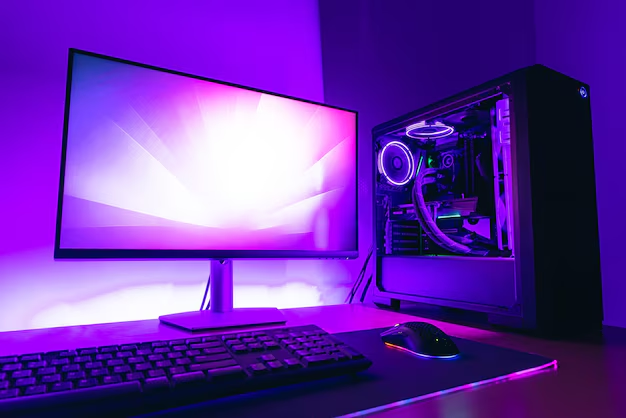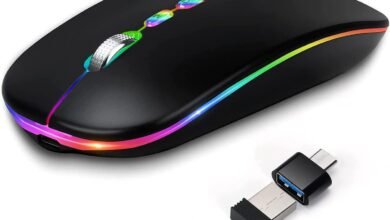PC LED: The Bright Evolution of Computing Illumination

Introduction to PC LED Technology
PC LED When people think of computers, they often focus on processors, memory, or storage. Yet, over the past decade, one of the most striking shifts in personal computing has not been about raw power alone but rather about aesthetic and functional lighting. PC LEDs, once dismissed as a mere “gimmick,” have matured into a defining element of modern systems. From subtle ambient lighting to dazzling RGB patterns, LED integration in PCs is reshaping how we experience computing, gaming, and even workstations.
What makes PC LED setups especially fascinating is their dual role. On one hand, they serve a practical purpose—illuminating dark workspaces, signaling system performance, or aiding cooling system visualization. On the other hand, they represent personality and customization, allowing every PC owner to express individuality through colors, effects, and synchronized patterns. In essence, LEDs are more than lights; they are visual storytellers for machines.
Interestingly, the rise of PC LEDs coincides with cultural shifts. Computers are no longer cold gray boxes tucked under desks. Instead, they are extensions of identity—like sneakers or watches. That cultural association has given LEDs new importance: they transform PCs into lifestyle objects. The glow from your tower isn’t just about brightness; it’s about character.
By exploring PC LED technology, one begins to appreciate how something as seemingly simple as light can revolutionize design, user experience, and even market trends. Let’s dig into how this evolution unfolded and why it’s continuing to grow.
The Evolution of PC Lighting: From Indicators to Artistry

In the early days of computing, lights were purely functional. A simple red or green PC LED on the front of a beige tower would tell you if the power was on or if the hard drive was active. These tiny diodes were practical, but hardly anything more. Their sole purpose was communication, not decoration. Fast-forward to the modern era, and LEDs are no longer modest indicators; they have become the defining aesthetic of PCs.
The transformation began in the late 2000s with gaming hardware manufacturers experimenting with customizable case lighting. What started as neon tubes or single-color LEDs soon evolved into fully programmable RGB ecosystems. Suddenly, gamers could make their rigs glow in sync with in-game actions, music beats, or even seasonal moods. What was once an afterthought became a selling point.
By the mid-2010s, RGB LEDs had become mainstream. Every major hardware component—from RAM sticks to cooling fans, from keyboards to graphics cards—was integrated with LED capabilities. This wasn’t accidental. The industry recognized that consumers wanted personalization. The glowing colors weren’t just aesthetic; they created a sense of ownership. A gamer’s rig was no longer “just another PC”—it was their PC, reflecting mood, style, and creativity.
Today, LEDs have transcended gaming culture. Designers, streamers, and even business professionals utilize LED setups to enhance productivity, reduce eye strain, or set a specific working ambiance. The lighting trend is not just a technological quirk—it’s a cultural phenomenon rooted in self-expression.
Functional Value of PC LEDs Beyond Aesthetics
It’s easy to dismiss PC LEDs as “just decoration,” but in reality, their role extends much deeper. Modern LED systems are built with a surprising amount of utility, combining form and function seamlessly.
First, LEDs enhance usability in dim environments. For night owls, backlit keyboards and LED-lit cases make computing comfortable without requiring harsh overhead lights. Adjustable brightness allows users to set a glow that doesn’t strain the eyes, creating an optimal balance between visibility and comfort.
Second, LEDs can act as diagnostic tools. High-end motherboards and GPUs now use LEDs to display error codes, temperatures, or system health indicators. Instead of relying on vague beeping sounds or cryptic BIOS codes, users can interpret colors or patterns instantly. Imagine your PC fans glowing red to indicate overheating or pulsing blue to reflect stable cooling—this visual communication is not only practical but also intuitive.
Third, LEDs contribute to the thermal performance of systems. While LEDs themselves don’t cool components, they are often paired with cooling fans and liquid systems that make airflow visible. A well-lit cooling loop allows enthusiasts to inspect liquid levels or spot irregularities at a glance. This integration demonstrates how LEDs bridge the gap between style and maintenance.
Finally, LEDs foster productivity and focus. Many professionals configure their workspaces with neutral or warm LED tones to reduce fatigue. For creative workers, lighting setups can trigger specific moods: a cool blue for deep concentration, a vibrant purple for brainstorming, or a calming white for long coding sessions. Far from being “just pretty,” LEDs have psychological and ergonomic benefits that subtly improve the computing experience.
PC LED Customization: A World of Creativity
One of the most remarkable aspects of PC LED culture is customization. No two setups need to look alike, and enthusiasts often treat their PCs like canvases. Software platforms such as ASUS Aura Sync, MSI Mystic Light, and Corsair iCUE have made it possible to design lighting schemes that are as simple or elaborate as the user desires.
The range of effects is vast. You might choose a static glow to match the color of your room or enable dynamic effects like waves, ripples, or reactive pulses that respond to your keyboard strokes. For gamers, the ultimate thrill comes from synchronization. Imagine your rig glowing red when your character takes damage, or the lights flashing in sync with explosions during gameplay. This immersive experience bridges the gap between the digital and physical world.
Beyond gaming, LED customization is also about artistry. Many PC builders spend hours coordinating themes, from cyberpunk neon designs to minimalist white-on-white glows. Some even design rigs that reflect their favorite shows, sports teams, or seasons. Holiday themes, for example, allow LEDs to become festive decor, turning a workstation into a lively piece of celebration.
Interestingly, the rise of social media has amplified this culture. Platforms like Reddit’s r/battlestations or Instagram are filled with users showcasing their LED setups. This has turned PC building into a creative hobby where lighting plays as big a role as performance. The sharing culture further drives innovation, inspiring others to experiment with their own styles.
The Future of PC LEDs: Beyond RGB
While RGB lighting is still in its prime, the future of PC LEDs is pointing toward even more sophisticated possibilities. Emerging technologies like micro-LEDs, smart adaptive lighting, and integration with AI are already hinting at what’s next.
Micro-LEDs promise more vibrant colors, higher brightness, and better energy efficiency. As these become mainstream, PCs will feature lighting that is sharper, smoother, and more environmentally friendly. This could lead to ultra-thin lighting strips or components where LEDs are seamlessly embedded without bulk.
Adaptive lighting is another frontier. Imagine LEDs that automatically adjust to your room’s brightness, matching the time of day. In the morning, they could emit energizing white light; by evening, they could shift to warm tones to promote relaxation. Some systems already experiment with these features, but future PCs may integrate them as standard.
Artificial intelligence could take customization even further. Instead of manually programming patterns, AI could learn user preferences over time, creating lighting schemes that adapt to moods, activities, and even health conditions. For example, your PC could detect stress during long work sessions and automatically switch to calming colors.
The future may also see LEDs merging with augmented reality (AR) and mixed-reality setups. Lighting could interact with virtual environments, extending the boundaries of immersion. It’s not hard to imagine a workspace where physical LED glow complements holographic projections, blurring the line between hardware and experience.
Conclusion: Why PC LEDs Are More Than Just Lights
PC LEDs have journeyed from being humble indicators to becoming cultural icons of modern computing. They symbolize the shift from computing as a purely functional activity to one that merges performance, personalization, and even wellness. The glow of a PC today is more than a status symbol; it’s a language of expression, a signal of creativity, and sometimes even a tool for productivity.
What makes PC LEDs remarkable is their adaptability. They fit seamlessly into gaming culture, creative industries, and professional workspaces, proving that technology can serve multiple roles simultaneously. Whether used to enhance gameplay, reduce eye strain, or simply bring a smile with colorful effects, LEDs have secured their place as a permanent feature of modern PCs.
As the technology continues to evolve, we can expect LEDs to become even more intelligent, immersive, and integrated. But one thing is clear: the era of dull, lifeless computer boxes is over. The PC of today and tomorrow glows—literally—with possibility.



